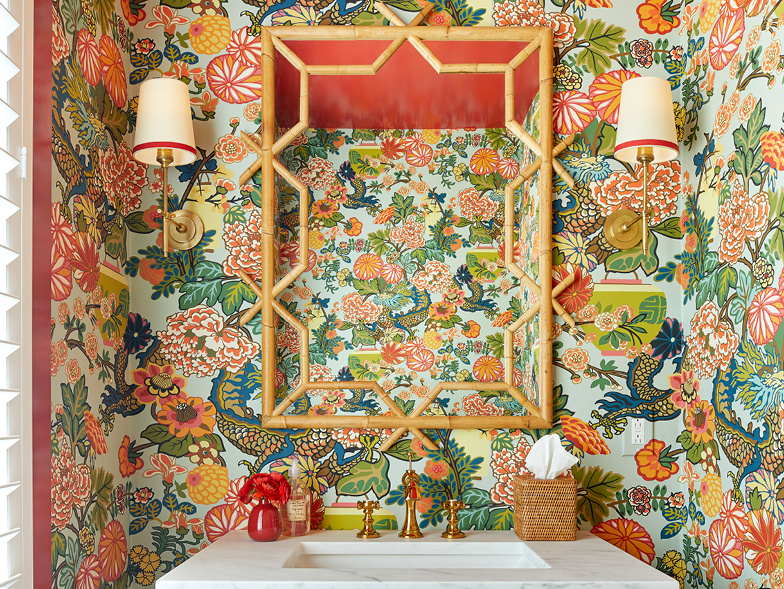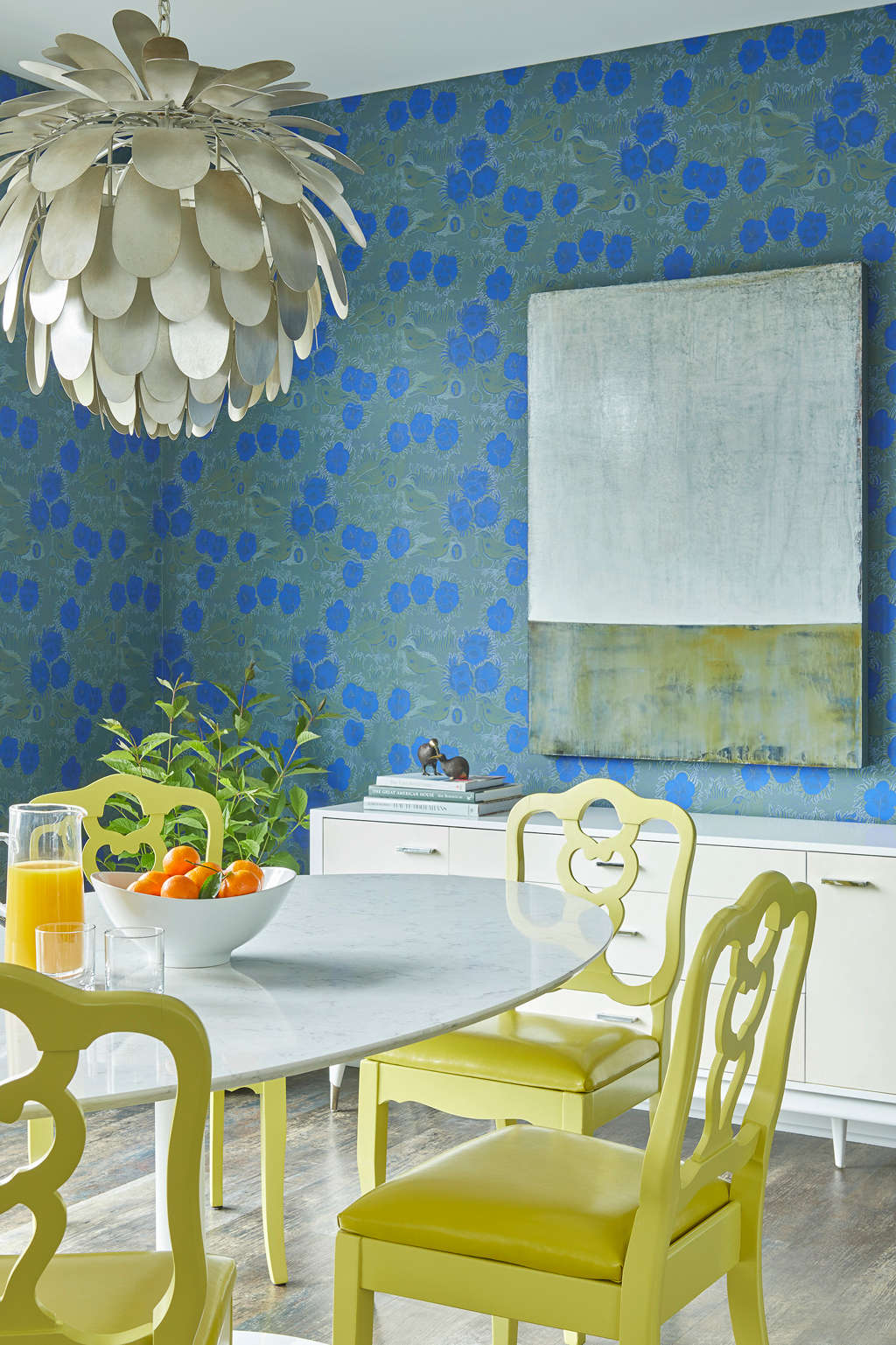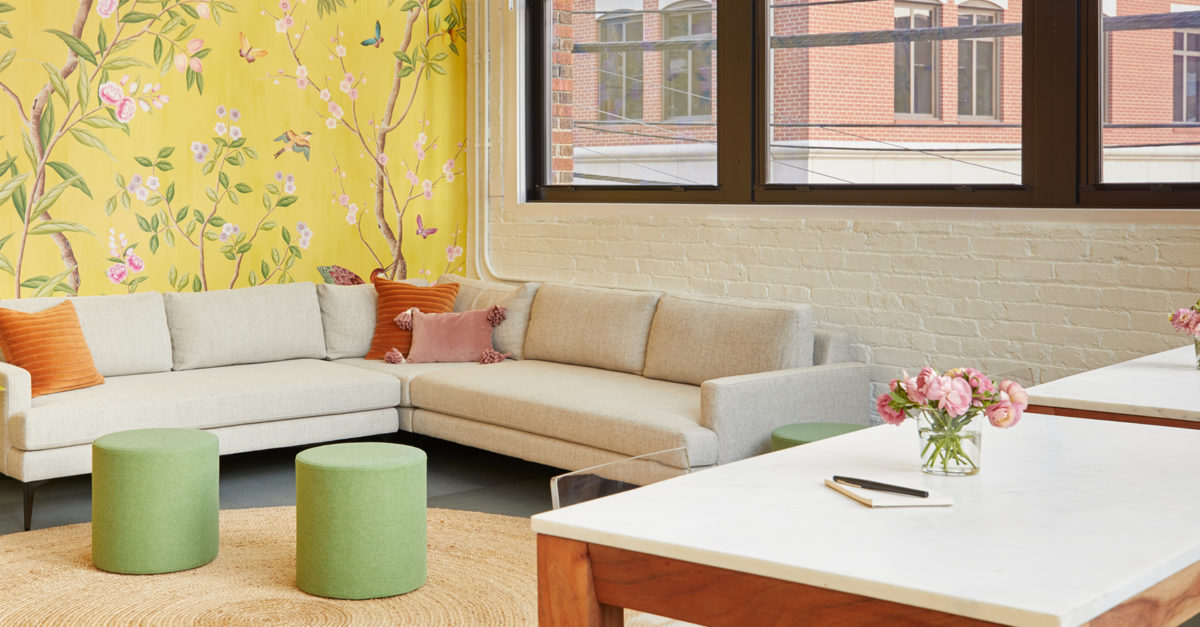Wallpaper Queen
Pittsburgh-based interior designer Colleen Simonds unrolls her best advice on building strong spaces using dynamic wallpaper patterns and gutsy design choices.

Will you give us a snapshot of your professional journey?
After I graduated from Duke University, I moved to San Francisco to work for Gap, Inc. in their Executive Training Program. That led to a twelve-year career in merchandising at Gap, Inc. and eventually J. Crew in New York City. I then left J. Crew and went to Parsons School of Design to pursue interior design in their associate’s degree program (for second-career kind of people like me). I got my first client soon after that and started working. This was also the same year I gave birth to our first child. My husband and I left New York and moved back to Pittsburgh (where we are both from) in 2017.
What makes interior design the ideal career for you?
It combines all my favorite things: color, pattern, beauty, shopping, problem-solving, and transformations. I was able to build on all the skills I learned in merchandising and apply them to designing rooms and homes. I also love houses; I thought I wanted to be an architect when I was growing up.
What is your biggest design pet peeve?
Rooms without personality. If you can’t tell anything about who might live there, the room hasn’t done its job. A room should make you smile. I always want warmth and personality.
If you could give everyone design advice, what would it be?
Take a risk! No risk, no reward in design. And surround yourself with things that you truly love—your environment matters.

How would you describe your style?
My design is generally clean, colorful, edited, and strong. I like spaces that feel like a statement. I understand color and how colors work together to create a mood.
Why do you gravitate toward wallpaper? What does it bring to a space?
Wallpaper instantly creates a mood. It can even do a lot of the work for you as a designer if you use something strong. Walls and color are the first things I think about in a room when I start to design because they set the tone.
When you’re designing, how do you decide which rooms will have wallpaper? Is there a limit on how many rooms one should wallpaper?
I don’t think there’s a limit on how many rooms you should wallpaper. It depends on what kind of house you have and its architecture. Open floor plans make using wallpaper tough since you often don’t have clean starting and stopping points. And in very large rooms, it can be too much. You should consider the feel and style of the house and what you’re trying to achieve. I like to wallpaper ceilings sometimes if four wallpapered walls feel like too much. You want your house to feel cohesive. When people walk through the space, it should feel like one continuous thought, like the same people live there from room to room.
Do you have favorite patterns or types of wallpaper?
I always gravitate toward more graphic patterns. I love a bird, a tree, flowers, greens—anything that feels like it’s outside and organic. But I especially love if the pattern has more of a clean, graphic edge versus something super traditional. Of course, I love multicolor paper because it gives you so much to work with in a room. I prefer that over two-color rooms. And I love grass cloth when you want warmth, texture, and maybe color but not pattern. It is so cozy. And stripes always! I also have a couple of favorite patterns: Peter Dunham Fig Leaf and Birger Kaipiainen’s Night of the Skylarks. But I also love discovering new lines.

What are some guiding principles to layering wallpaper, artwork, and furnishings? Can you hang art on a busy pattern?
You can absolutely hang artwork on busy wallpaper patterns. Contrasts usually work best, like a floral with something graphic. Your eye needs a place to rest for a minute so it can take everything in. Art with a white mat works well on busy, colorful paper because the mat provides a visual break between the two. There are no hard-and-fast rules, though. And sometimes really amazing wallpaper is the art; you don’t need to hang very much or sometimes anything at all.
Will you talk about how wallpaper ended up on the ceiling of your kitchen?
I didn’t plan to wallpaper our kitchen ceiling, but that room needed one more element. It felt too cold. I didn’t want to put a rug under our kitchen table because young kids eat there three times a day. And we already had large, very bold artwork on the walls, so wallpaper on the walls didn’t seem right, either. Since the ceiling is ten feet high, that felt like the place. And the pattern (my favorite: Peter Dunham Fig Leaf in blue on white) is the outside element I was talking about. It’s so optimistic and happy, and I love looking at it. It also tied into my very dark-navy kitchen cabinets. When I saw it, I knew it was perfect. Fun fact: I didn’t tell my husband I was having it done while we were on vacation. He was a bit shocked, but now he loves it.
Will you talk about the floral-wallpapered bathroom that has become Instagram famous?
I have amazing wallpaper installers and have only ever had one problem; it was with a powder room with the incredible Chiang Mai Dragon paper by Schumacher. My client told me the paper looked sloppy, and it did. Luckily, the installers agreed and covered the new paper and the labor to redo it, though I had offered to pay half. Those situations are challenging as a designer—it’s not your client’s fault, so they shouldn’t have to pay for a mistake. That’s just how this business goes. You want the end result to be right so badly. And now that bathroom has been all over Instagram!

What are the most common mistakes you see people make with wallpaper?
Wallpaper is there to make a statement, so let it. People can be too timid with it. I don’t like accent walls, either, for the same reason. Do it or don’t do it. I’m also not a fan of metallics and shiny paper, but that’s a personal preference.
How have you changed as a designer over the course of your career?
Well, my hair is now completely white, so that might be an indication of my age and years, and maybe stress too. I don’t think my style and sensibility have changed that much, but I have learned a lot. I’ve made so many tough mistakes along the way. Because this is a job of doing, you learn from experience. I also notice that I gravitate toward more traditional elements as I age. I might have been more into trendy or contemporary things years ago, and I still like some of that, but the priority has shifted to comfort, warmth, and coziness. And, of course, color.
For more info, visit colleensimonds.com






















